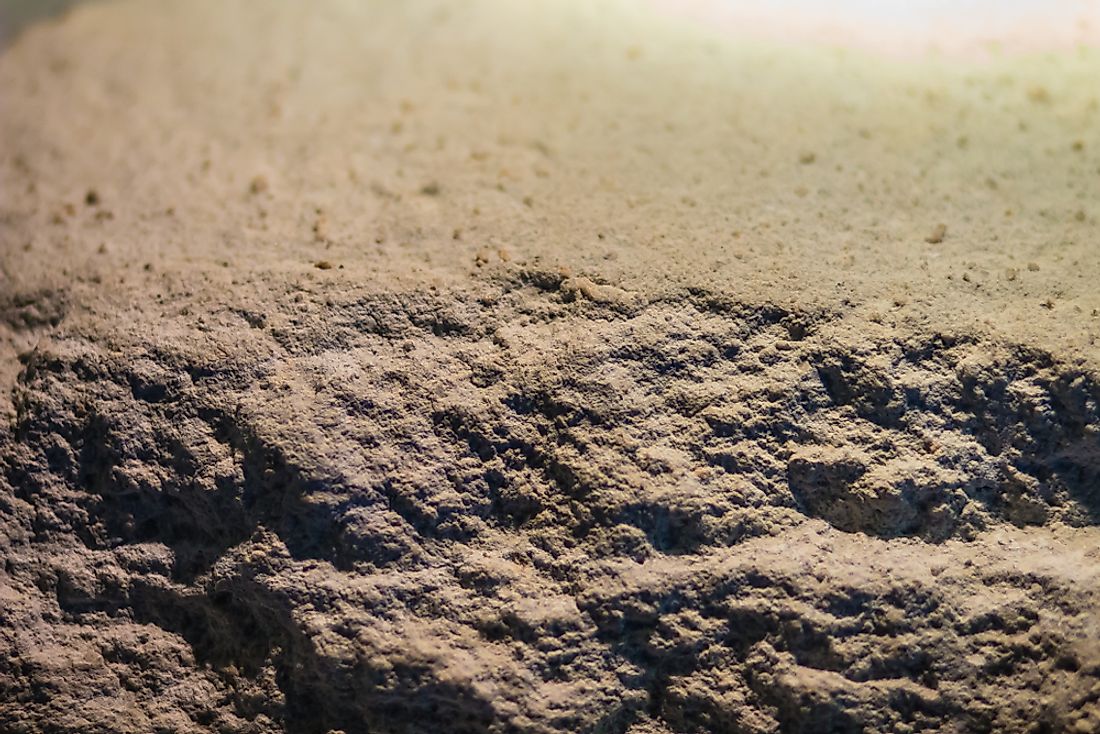What Is Tuff?

When a volcanic eruption occurs, there are different types of volcanic materials which are ejected into the atmosphere and onto the surface. The materials include volcanic gases, lava, and tephra. Volcanic gases are mainly water vapor, carbon dioxide, and either Sulphur dioxide or hydrogen sulfide. While lava is made up of crystals, liquids, and bubbles mixture which are typically pushed onto the surface during the eruption. Tephra is large rock fragments of different sizes and shapes which are formed when magma is explosively ejected into the atmosphere by the expansion of volcanic gases. The fragments with a diameter less than 2mm will be deposited further from the volcano to form volcanic ash. Out of the accumulated and consolidated volcanic ash deposits, a tuff is formed.
Description
The word tuff comes from the Italian word tufo which means the type of rock formed out of consolidated deposits of volcanic ash after the explosive volcanic eruption. Tuffs are comparatively soft. Most tuffs consist wholly or in part, of volcanic materials with a varying level of fineness. Some have a mixture of wood, vegetation matter, and land shells while others formed from the eruption of volcanoes located near the sea will have their ash mixed with rock sediments thrown from the seabed to form tuff as a mixture of limestone, sand, fossil shells and clay soil. The content of the ash deposits may also contain less or more crystalline igneous rocks, for example, leucite, augite and olivine deposits found on the side and ash bed of Vesuvius. Where these crystals are many, they are called crystal tuff.
Types
Tuffs are typically classified based on the type of rock fragments found in them.
Rhyolitic
Rhyolitic consists mainly of igneous crystal volcanic ash deposits with high silicon content. Rhyolitic tuff is composed of quartz, plagioclase, and sanidine with a small amount of hornblende and biotite. Rhyolitic tuff is found in Iceland, Hungary, New Zealand, Lipari Islands, Guatemala, and Yellowstone National Park in the US among other areas.
Trachyte
Trachyte tuff is made up of extrusive igneous rock whose main chemical component is alkali feldspar, and it does not have quartz. They are found on Rhine, Hungary, and on mountain Kilimanjaro in Tanzania among other regions.
Basaltic
Basaltic tuff is composed of a dark colored and fine-grained igneous rock whose chemical elements are plagioclase, pyroxene, and olivine. They may also contain shale, sandstone, grit and occasionally fossiliferous. Basaltic tuff s are mainly found in Hawaii Islands and New Zealand.
Ultramafic
The composition of ultramafic tuff is characterized by the abundance of olivine and no feldspar and quartz. It can sometimes be found on unusual surface deposits of maars of kimberlites. Kimberlite is an igneous rock which at times contains diamond. These rock types are common in South Africa.
Andesitic
Andesitic tuff is formed from extrusive igneous rocks which are an intermediate between rhyolite and basalt rocks. The rocks are composed of plagioclase feldspar and biotite pyroxene with no quartz or olivine. They are formed out of the lava which have cooled rapidly at the surface. They exist in different colors but are typically bluish – grey. They are found mainly in West Indies, New Zealand, and Japan.
Significance
Tuffs were used and continue to be used for various purposes. The soft nature of its rock materials makes it ideal for use in different construction projects. In the ancient times, the Romans used basalt as aggregates in the construction of buildings and bridges. In the modern times, basalt is used as aggregates in the construction of railroads and road bases. In the US, a tuff is being used as storage facility for spent nuclear reactors and radioactive wastes while in Germany tuffs are widely used as hydraulic mortar.











